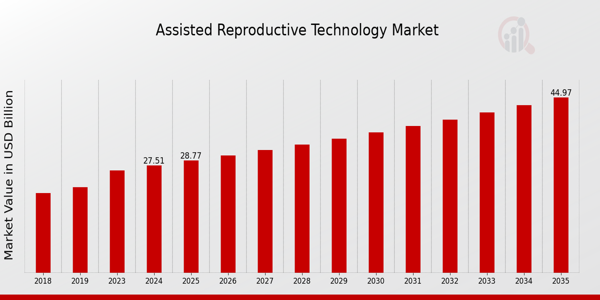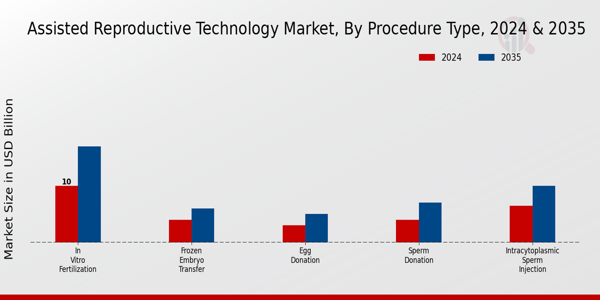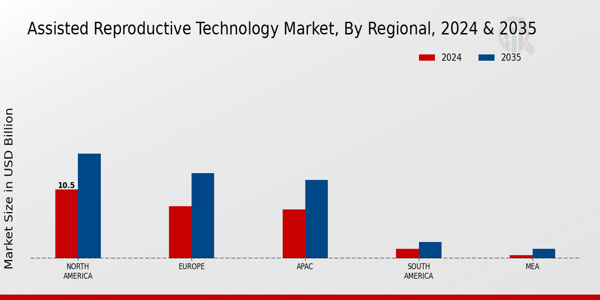Assisted Reproductive Technology Market Overview
As per MRFR analysis, the Assisted Reproductive Technology Market Size was estimated at 26.31 (USD Billion) in 2023. The Assisted Reproductive Technology Market is expected to grow from 27.51 (USD Billion) in 2024 to 45 (USD Billion) by 2035. The Assisted Reproductive Technology Market CAGR (growth rate) is expected to be around 4.57% during the forecast period (2025 - 2035).
Key Assisted Reproductive Technology Market Trends Highlighted
A number of important variables are propelling the notable expansion of the global market for assisted reproductive technologies. The rising incidence of infertility, which impacts a significant section of the population in different areas, is one of the main factors propelling the market.
This increase has been caused by a combination of medical disorders, environmental causes, and changes in lifestyle, which has led more individuals and couples to seek therapy. People are also becoming more interested in assisted reproductive choices as a result of technological breakthroughs and more knowledge about reproductive health.
The changing social norms surrounding family planning are another important factor, as more people choose to put off having children, which raises the need for fertility treatments. The advent of cutting-edge technology like artificial intelligence, which can improve treatment success rates, and the growth of clinical services in emerging nations are two opportunities to investigate in this sector.
Partnerships between technology companies and fertility clinics may also enhance patient outcomes and experiences. As patients look for individualized treatments based on their unique needs and medical histories, a trend toward personalization in treatment programs has emerged in recent years.
Additionally, the growth of telemedicine has facilitated easier access to follow-up care and consultations, enabling more extensive patient outreach and support on a global scale.
This is in line with the growing need for all-encompassing, patient-focused care in the field of assisted reproductive technology, which places a focus on better access and effectiveness in fertility treatments globally. The global market for assisted reproductive technologies will be shaped by these trends as they develop further, offering a plethora of opportunities for expansion and innovation.

Source: Primary Research, Secondary Research, MRFR Database and Analyst Review
Assisted Reproductive Technology Market Drivers
Increase in Infertility Rates
The rising rates of infertility globally are significantly driving the growth of the Global Assisted Reproductive Technology Market. According to the World Health Organization, approximately 15% of couples experience infertility issues, with the prevalence increasing due to factors such as delayed childbearing, lifestyle changes, and increasing stress levels.
Countries such as the United States and Europe have reported surges in infertility treatments, leading to a heightened demand for technologies like in-vitro fertilization (IVF) and intracytoplasmic sperm injection (ICSI).
Additionally, the American Society for Reproductive Medicine reports that more than 1 million IVF cycles are performed annually in the United States alone. As a result, healthcare providers and clinics are expanding services to meet this growing need, propelling the Global Assisted Reproductive Technology Market forward.
Technological Advancements in Reproductive Health
Technological innovations in reproductive health are transforming the Global Assisted Reproductive Technology Market. Advancements such as preimplantation genetic testing (PGT), cryopreservation techniques, and automation in laboratories are improving success rates of assisted reproductive processes.
For instance, the introduction of artificial intelligence in embryo selection has been recognized for its potential to enhance the precision of treatment outcomes.
Organizations like the European Society of Human Reproduction and Embryology emphasize the importance of these technologies in increasing the live birth rates associated with ART. Such innovations are making treatments more accessible and effective, ultimately driving market growth.
Government Support and Initiatives
Government support and initiatives play a crucial role in fostering the growth of the Global Assisted Reproductive Technology Market. Various countries are implementing policies that support fertility treatments and reproductive health services.
For example, several European nations have developed subsidized ART programs that aim to alleviate the financial burden on patients. According to the Fertility Network UK, governmental funding in these programs has increased access to treatments, with countries like Denmark exhibiting high success rates in ART procedures.
Governments are also investing in Research and Development to improve fertility treatments and promote public awareness regarding reproductive health, further propelling market expansion.
Rising Awareness and Acceptance of ART
The rising awareness and societal acceptance of assisted reproductive technologies are significantly impacting the Global Assisted Reproductive Technology Market. Public campaigns and educational initiatives have contributed to a more positive perception of infertility treatments.
In regions like Asia, where traditional stigma around infertility was prevalent, increasing awareness has led to a higher acceptance of ART procedures.
Notably, the Indian Medical Association has been actively promoting educational programs addressing misconceptions surrounding ART, facilitating a cultural shift towards seeking medical help for infertility issues. This increased visibility and understanding of ART options are expected to contribute to sustained market growth in the coming years.
Assisted Reproductive Technology Market Segment Insights:
Assisted Reproductive Technology Market Procedure Type Insights
The Global Assisted Reproductive Technology Market witnessed significant growth, particularly within the Procedure Type segment, which encompassed In Vitro Fertilization, Intracytoplasmic Sperm Injection, Frozen Embryo Transfer, Egg Donation, and Sperm Donation.
In Vitro Fertilization dominated this segment with a projected valuation of 10.0 USD Billion in 2024, growing to 17.0 USD Billion by 2035, which illustrated its significant contribution to the overall market.
This procedure's dominance was largely due to its widespread use among couples facing infertility and was often viewed as the first line of treatment, reflecting societal trends towards delayed childbirth and increasing awareness of reproductive health.
Moreover, the Intracytoplasmic Sperm Injection followed closely with a valuation of 6.5 USD Billion in 2024, anticipated to rise to 10.0 USD Billion by 2035. This method was especially pivotal for couples dealing with male infertility, making it vital in the overall treatment landscape.
Frozen Embryo Transfer held a valuation of 4.0 USD Billion in 2024 with a potential increase to 6.0 USD Billion, benefiting from the trend of increased success rates and flexible treatment timings. Egg Donation, valued at 3.0 USD Billion in 2024 and expected to reach 5.0 USD Billion, highlighted the importance of donor programs and the growing acceptance of third-party reproduction in many cultures.
Lastly, Sperm Donation contributed 4.01 USD Billion in 2024, expanding to 7.0 USD Billion, demonstrating a steady increase in demand for sperm banking and its crucial role in Assisted Reproductive Technology.
Overall, this Procedure Type segment reflected significant market growth driven by changing demographics, technological advancements in reproductive medicine, and a global increase in infertility treatments.
As global healthcare continues to evolve, there are numerous opportunities present for innovation and improvement across all these procedures, making their effective implementation essential for addressing the increasing reproductive health challenges faced by couples worldwide.
This comprehensive understanding of the Global Assisted Reproductive Technology Market segmentation provides valuable insights into the relevant trends and growth drivers, which are shaping the market's future trajectory.

Source: Primary Research, Secondary Research, MRFR Database and Analyst Review
Assisted Reproductive Technology Market End User Insights
The Global Assisted Reproductive Technology Market revenue reflects a rapidly evolving landscape. The end user segment plays a critical role in this growth, comprising various settings such as fertility clinics, hospitals, and home care packaging.
Fertility clinics are significant contributors, focusing extensively on specialized reproductive treatments, drawing individuals seeking personalized care. Hospitals also play a pivotal role in integrating assisted reproductive technologies within broader healthcare services and providing patients with comprehensive medical support.
Home care is emerging as a vital segment, emphasizing flexibility and comfort for patients undergoing treatment, addressing the growing demand for less invasive options. The overall Global Assisted Reproductive Technology Market statistics illustrate a steady increase, driven by rising infertility rates, advanced reproductive techniques, and evolving societal acceptance of assisted reproduction.
The convergence of technological advancements in these end-user segments offers both challenges and opportunities, bringing efficient care to the forefront while responding to the diverse needs of patients globally.
Assisted Reproductive Technology Market Technology Insights
The Technology segment encompasses various innovative practices, with significant emphasis on methods such as Cryopreservation, Preimplantation Genetic Diagnosis, and Assisted Hatching.
Cryopreservation plays a crucial role in preserving reproductive cells and tissues, enhancing the chances of successful pregnancies. Preimplantation Genetic Diagnosis addresses genetic disorders, thus contributing to healthier outcomes for patients.
Furthermore, Assisted Hatching aids embryo implantation by facilitating the hatching process, proving essential for successful pregnancies in challenging cases. As the Global Assisted Reproductive Technology Market continually evolves, the integration of these technologies is seen as a catalyst for market growth, responding to increasing demand for effective fertility solutions.
Market growth is further supported by rising awareness and acceptance of assisted reproductive technologies globally. However, challenges such as regulatory hurdles and high treatment costs persist, presenting both obstacles and opportunities for further innovation in the sector.
The Global Assisted Reproductive Technology Market data suggests a steady increase in demand, reflecting an ongoing commitment to developing advanced reproductive solutions.
Assisted Reproductive Technology Market Product Type Insights
The Global Assisted Reproductive Technology Market demonstrates a diverse product type segmentation, primarily encompassing Reagents, Consumables, and Equipment, each playing a pivotal role in enabling successful reproductive procedures.
Reagents serve as essential components in numerous fertility treatments, contributing directly to the success rates of procedures such as in-vitro fertilization (IVF), and are crucial in laboratory settings. Consumables, representing a significant share of the market, facilitate the actual procedures, ensuring that clinics are well-equipped to meet patient needs effectively.
Equipment, incorporating innovative technologies like cryopreservation tanks and incubators, underscores the importance of advancements in the efficiency of reproductive treatments. Each of these product types supports the overall goal of improving outcomes in fertility treatments, addressing the growing global concern of infertility, which affects approximately 15% of reproductive-age couples.
The changing demographics and rising awareness about assisted reproductive technologies are key growth drivers, enhancing the importance of these segments in the Global Assisted Reproductive Technology Market alignment and making it a focal point for investments.
Assisted Reproductive Technology Market Regional Insights
The Global Assisted Reproductive Technology Market revenue is poised to showcase significant activity across various regions, with North America, Europe, APAC, South America, and MEA contributing distinctively.
In 2024, North America held a majority with a valuation of 10.5 USD Billion, driven by advanced healthcare infrastructure and increasing infertility rates, which necessitate assisted reproductive solutions. Europe followed closely at 8.0 USD Billion, benefiting from strong regulatory frameworks and public awareness about reproductive health.
APAC, with a market value of 7.5 USD Billion, steadily emerged due to rising disposable income and changing societal norms regarding family planning. South America and MEA exhibited smaller market values of 1.5 USD Billion and 0.5 USD Billion respectively in 2024, reflecting varied patient access to services and cultural attitudes toward reproductive technology.
While North America and Europe dominated due to their established healthcare facilities, APAC shows promising growth potential, driven by increasing urbanization and healthcare investments.
As the Global Assisted Reproductive Technology Market segmentation indicates, these disparities in regional valuations emphasize the need for tailored marketing and educational efforts to enhance adoption rates across different regions.

Source: Primary Research, Secondary Research, MRFR Database and Analyst Review
Assisted Reproductive Technology Market Key Players and Competitive Insights:
The Global Assisted Reproductive Technology Market has seen significant growth, driven by advancements in medical technology and increasing public awareness regarding fertility issues. As the demand for infertility treatments rises, various stakeholders, including pharmaceutical companies, healthcare providers, and fertility clinics, have intensified their efforts to offer innovative solutions.
The competitive landscape within this market is characterized by a blend of established players and emerging innovators, each striving to enhance their service offerings, improve patient outcomes, and expand their market reach. The strategies employed encompass mergers and acquisitions, product diversification, and geographical expansion, all aimed at capturing a larger share of this lucrative market.
Ferring Pharmaceuticals has established a strong presence in the Global Assisted Reproductive Technology Market by leveraging its robust research and development capabilities to create and deliver a range of fertility products.
The company's strengths lie in its commitment to innovation, evidenced by a consistent pipeline of new therapies designed to improve reproductive outcomes for patients facing infertility. Ferring Pharmaceuticals has positioned itself strategically within the market through partnerships with fertility clinics worldwide, ensuring the availability of its products in key global locations.
Their focus on patient-centric solutions, combined with a deep understanding of reproductive health, further strengthens their competitive stance, making them a trusted name among healthcare providers and patients alike.
CReATe Fertility Centre offers a comprehensive suite of services targeted at addressing various aspects of assisted reproduction on a global scale. The center is renowned for its state-of-the-art facilities and evidence-based approaches that enhance the success rates of fertility treatments, including in vitro fertilization and egg donation, among others.
CReATe Fertility Centre has expanded its market presence through strategic partnerships and collaborations aimed at integrating cutting-edge technologies within its services. The center emphasizes personalized care, working closely with patients to tailor treatment plans that optimize outcomes.
Their strengths also include a well-defined patient support system and a network of professionals dedicated to reproductive health. In recent years, CReATe Fertility Centre has been active in seeking opportunities for mergers and acquisitions to enhance its service portfolio and strengthen its position within the global assisted reproductive technology arena.
Through these initiatives, the center is committed to expanding its global footprint, thereby reaching a larger demographic seeking fertility assistance.
Key Companies in the Assisted Reproductive Technology Market Include:
- Ferring Pharmaceuticals
- CReATe Fertility Centre
- Thermo Fisher Scientific
- IVF Technologies
- Reproductive Health Specialists
- Cryoport
- SAGE BioPharma
- Bourn Hall Clinic
- Merck KGaA
- Ovascience
- Genea Limited
- CooperSurgical
- Eugene Science
- Irvine Scientific
- Genesis Fertility Clinic
Assisted Reproductive Technology Market Developments
Recent developments in the Global Assisted Reproductive Technology Market indicate significant growth and innovation, driven by increasing demand for fertility treatments. Notably, Ferring Pharmaceuticals announced advancements in hormone therapies for reproductive health in October 2023.
CReATe Fertility Centre has expanded its services across North America, enhancing patient access to IVF methodologies. Thermo Fisher Scientific has rolled out new laboratory solutions aimed at optimizing cryopreservation processes.
In terms of market movements, Cryoport reported increased revenue driven by the growing need for temperature-controlled logistics solutions, which is pivotal for assisted reproductive services. A recent acquisition was noted in August 2023 when CooperSurgical acquired reproductive health assets from Merck KGaA, strengthening its position in the fertility market.
Over the past few years, the overall valuation of this sector has surged, with Genesis Fertility Clinic experiencing a 30% increase in patient volume over the last two years, reflecting an upward trend in fertility treatments.
Analysts attribute this growth to a rising awareness of reproductive health and advancements in technology, significantly impacting both service availability and patient outcomes globally. The inclusive landscape of assisted reproductive technology illustrates a robust future for both providers and patients alike.
Assisted Reproductive Technology Market Segmentation Insights
Assisted Reproductive Technology Market Procedure Type Outlook
- In Vitro Fertilization
- Intracytoplasmic Sperm Injection
- Frozen Embryo Transfer
- Egg Donation
- Sperm Donation
Assisted Reproductive Technology Market End User Outlook
- Fertility Clinics
- Hospitals
- Home Care
Assisted Reproductive Technology Market Technology Outlook
- Cryopreservation
- Preimplantation Genetic Diagnosis
- Assisted Hatching
Assisted Reproductive Technology Market Product Type Outlook
- Reagents
- Consumables
- Equipment
Assisted Reproductive Technology Market Regional Outlook
- North America
- Europe
- South America
- Asia Pacific
- Middle East and Africa
| Report Attribute/Metric Source: |
Details |
| MARKET SIZE 2023 |
26.31(USD Billion) |
| MARKET SIZE 2024 |
27.51(USD Billion) |
| MARKET SIZE 2035 |
45.0(USD Billion) |
| COMPOUND ANNUAL GROWTH RATE (CAGR) |
4.57% (2025 - 2035) |
| REPORT COVERAGE |
Revenue Forecast, Competitive Landscape, Growth Factors, and Trends |
| BASE YEAR |
2024 |
| MARKET FORECAST PERIOD |
2025 - 2035 |
| HISTORICAL DATA |
2019 - 2024 |
| MARKET FORECAST UNITS |
USD Billion |
| KEY COMPANIES PROFILED |
Ferring Pharmaceuticals, CReATe Fertility Centre, Thermo Fisher Scientific, IVF Technologies, Reproductive Health Specialists, Cryoport, SAGE BioPharma, Bourn Hall Clinic, Merck KGaA, Ovascience, Genea Limited, CooperSurgical, Eugene Science, Irvine Scientific, Genesis Fertility Clinic |
| SEGMENTS COVERED |
Procedure Type, End User, Technology, Product Type, Regional |
| KEY MARKET OPPORTUNITIES |
Expanding fertility awareness campaigns, Increased adoption of genetic testing, Rising demand for egg freezing, Technological advancements in IVF, Growth in male infertility treatments |
| KEY MARKET DYNAMICS |
Increasing infertility cases, Advancements in technology, Rising awareness and acceptance, Government support and funding, Growing demand for egg freezing |
| COUNTRIES COVERED |
North America, Europe, APAC, South America, MEA |
Assisted Reproductive Technology Market Highlights:
Frequently Asked Questions (FAQ) :
The Global Assisted Reproductive Technology Market is expected to be valued at 27.51 USD Billion in 2024.
By 2035, the market is anticipated to reach a valuation of 45.0 USD Billion.
The market is projected to expand at a CAGR of 4.57% from 2025 to 2035.
North America is expected to dominate the market, valued at 16.0 USD Billion by 2035.
In 2024, the In Vitro Fertilization segment is valued at 10.0 USD Billion.
Major players include Ferring Pharmaceuticals, CReATe Fertility Centre, and Thermo Fisher Scientific among others.
The Frozen Embryo Transfer segment is projected to reach 6.0 USD Billion by 2035.
The Egg Donation segment is valued at 3.0 USD Billion in 2024.
The APAC region is expected to show growth with a market size of 12.0 USD Billion by 2035.
Key trends include advances in technology, increasing infertility rates, and growing awareness and acceptance of assisted reproduction methods.


















